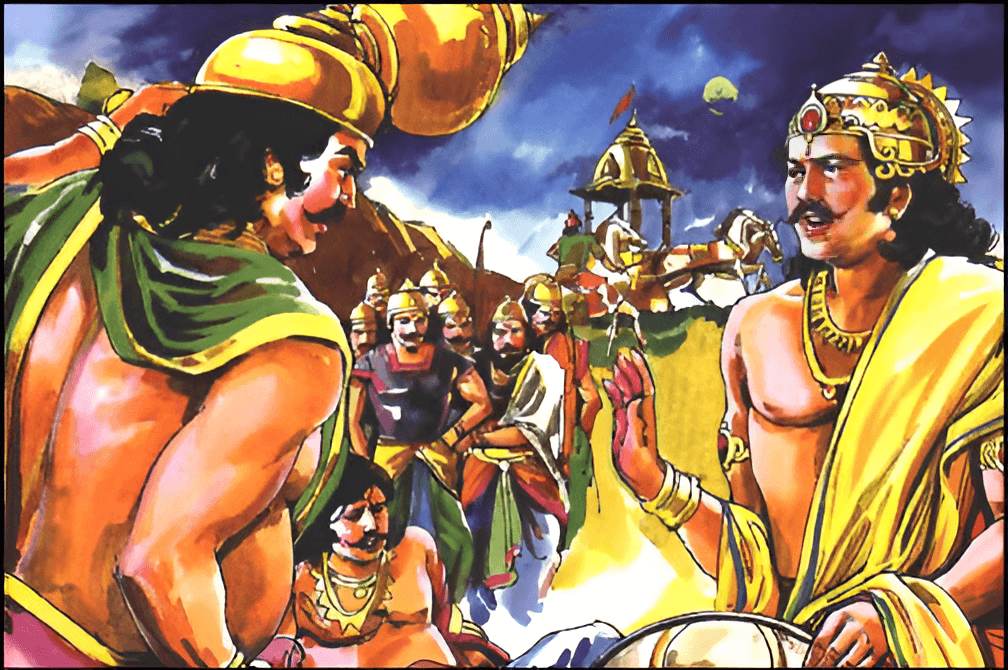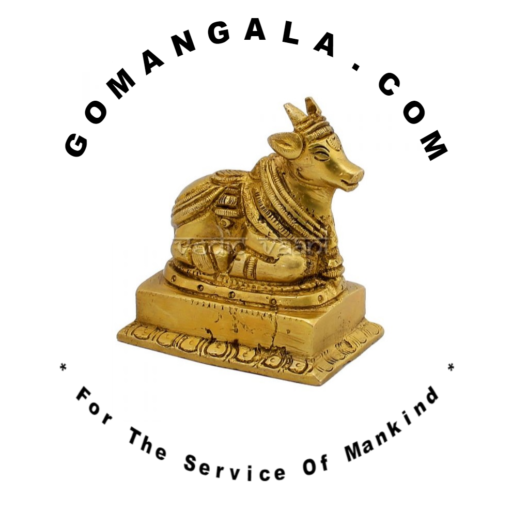Samasaptaka Parva is the sixty sixth Upa parva included in the seventh Maha parva named as Drona parva. Vaishampayana continued narration to Janamejaya in reply to his queries as follows.
How Drona had arranged the Mahabharata war on the twelfth day of war?
Under the commander-in-chief Drona, the Mahabharata war was fought for three days from the eleventh day morning up to the thirteenth day late night. There was rest for the fighting soldiers on the eleventh day night and on the twelfth day night but the war was not stopped.
Initially, Drona had thought the war should be fought by the soldiers in four parts taking shifts like a relay. One third of the soldiers should go for relief or for personal reasons out of the battle field into their war camps but one third should be always fighting with the enemy soldiers.

Karna was helping Drona on war time basis. Drona had arranged all medical facilities for the needy soldiers by order of Duryodhana. Drona had also arranged all kinds of food facilities for the needy soldiers. Pork (pig-meat) was supplied to the interested non-vegetarian soldiers with the choice of alcohol also. Drona had arranged all resting facilities for the needy soldiers in his war camps.
Ashwathama was not allowed by Duryodhana to fight directly in the battle field. He was allotted the risk of army intelligence, timely reporting of the war plans of the opposite side soldiers. So he was reporting to his father or to Duryodhana timely, avoiding his field exposure. Some of the soldiers started from their camp on the eleventh day morning but continued to proceed on fighting on the twelfth day also. The Samasaptaka warriors had not returned to their camps but went on fighting and died on the twelfth day.
Who were Samasaptakas? Who were Trigarta warriors?
There were seven superior powerful commanders who came from Trigarta kingdoms. They were brave and Drona had arranged various kinds of alignments of regiments using these Trigarta warriors, mainly focusing them on Arjuna. Shikhandi was also facing all these Trigarta warriors on the eleventh day morning, besides protecting Arjuna. Abhimanyu was protecting Yudhishtira on the eleventh day morning. On the eleventh day morning, Drona had arranged the Chakravyuha and succeeded in trapping Abhimanyu. Trigarta warriors were younger brothers of Susharma.
How the twelfth day war started and what Drona ordered to the Trigarta warriors?
Since there was no pause of the war in the evening, soldiers were engaged in action during the night also. Some of the soldiers were escaping, running for medicines into the camps or returning or resting after eight hours of action, or moving for resuming duty again. Fresh soldiers were entering into the battle fields wherever Drona directed or signalled. Drona ordered the Trigarta warriors to face Arjuna and Drishtadyumna. Drona was interested to capture Yudhishtira as a war prisoner and persuade Yudhishtira to surrender before Duryodhana.
What was the vow of Trigarta Warriors?
Trigarta warriors had taken a vow to kill Arjuna. All the seven warriors were attacking against Arjuna with the help of their soldiers. Dushasana was helping them on the side of Kaurava army with his mace fighting.
What was the vow of Drona?
Drona had declared his vow to capture Yudhishtira alive. So Drona ordered Trigarta warriors to face Arjuna and drive him away from Yudhishtira.
Why Satyaki had left away from Karna ?
On the twelfth day, Satyaki and Karna were fighting one another. Karna was engaged in fighting with Satyaki, so Arjuna was fighting with Samasaptaka warriors. In the evening, Krishna told Satyaki to leave away from Karna. Being tired by fighting with Karna, he left away from the battlefield. Krishna knew on the fourteenth day night, Karna would fight with Ghatotkacha using the most powerful weapon with the name as Vasavi Astra being preserved by him to kill Arjuna. Krishna knew neither Satyaki would fail nor Karna would fail on that day.
Who killed the Samasaptaka Trigarta warriors?
Arjuna had fought with the Trigarta warriors and five of them had been killed by him on the twelfth day before sunset. In the early night of the same day, Arjuna had killed the other two also. Susharma was the senior most of the Trigarta warriors. But the other soldiers of Samasaptakas were immediately brought under Karna and few of them were fighting for Duryodhana until the fifteenth day. Arjuna had killed most of the Trigarta soldiers on the fourteenth day of the war.
How Bhagadatta was killed?
Bhagadatta was from Pragjotishpura and he was a demon. Narakasura was a demon killed in action, described in this website under article Six important festivals of India. Later, Bhagadatta was installed as the demon king there. His style of war was suited for the demons. He was shooting his arrows towards Arjuna but all the arrows were accepted by Krishna as a garland and Krishna had worn them like his Vyjayantimala.
Arjuna desired to know the reasons for the particular actions of Krishna. Krishna started to explain and Arjuna was busy in the war but listening to him. A few years back, Bhagadatta got a boon to be killed only by the incarnation of Vishnu. When he faced Arjuna, Krishna had remembered his duties. Hence he saved Arjuna from the arrows of Bhagadatta. Bhagadatta was frustrated with his bow by aiming his stock of arrows and later desired to fight with a mace. But Bhima was in the battle field at a great distance, approaching him fast.
In order to kill Arjuna, Bhagadatta had thrown his mace towards Arjuna. It was reflected from the chest of Krishna and after rebounding, hit back the head of Bhagadatta, finally killing him before Bhima reached there. According to the boon, his soul directly entered the feet of Krishna leaving behind his mortal body, in the battlefield of Kurukshetra. Thus, Bhagadatta was killed as per his boon.
Why Sanjaya was describing the chariot horses having beautiful colours?
During the three days of war from the morning of the eleventh day up to the night of the thirteenth day, the soldiers used colorful horses. The chariots of the Sindhu kingdoms were shining in the battlefield with the colourful horses. They were brought from Panchala, the palaces of Shalya and Jayadratha. Due to various colours of the horses, the battlefield was appearing like a garden with colourful flying crickets.
Sanjaya had beautifully described to Dritarashtra in one exclusive chapter about the various colours of the horses. Since Arjuna was gaining and Drona was losing in the battlefield, in order to satisfy Dritarashtra, Sanjaya had started to describe the colours of the horses. Moreover, Susharma, the senior most of the Samasaptakas, or the Trigarta warriors, had his main business as supplying horses to various kings according to their requirements.
The colourful horses supplied by Susharma were such items to explain the war style for Sanjaya since Susharma was already killed in action by Arjuna on the twelfth day night. In order to soothe or pacify the worried Dritarashtra, Sanjaya started to describe the various escaping kings and their colourful horses. The narration was only to satisfy Dritarashtra.
What Arjuna had done after Samasaptaka Vadha?
After Samasaptaka Vadha, Arjuna was feeling to return to his camp. On that day, he could not find Abhimanyu anywhere in the battle field. So in the late night, he returned to his camp searching for Abhimanyu. Arjuna had not enquired with anybody, since everybody were tired by the day and night war held continuously. Arjuna had continued his search for Abhimanyu but he could not succeed in his attempts easily.
Why Abhimanyu was not seen there on the twelfth day?
Abhimanyu had already died on the eleventh day itself; in the next article Abhimanyu Parva, it is explained with details.
Next post, Mahabharat: Abhimanyu Parva would be more interesting.
Mahabharat: Pratijna Parva would be presented separately in another article.
On reading this story, children would gain more memory power, great moral strength in their life future; create a sense of self-reliance leading to peace and progress.
It is humbly prayed for the blessings of God Krishna upon us.
Readers may share this story with children, friends and family.

0 Comments
1 Pingback